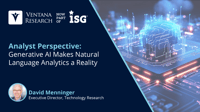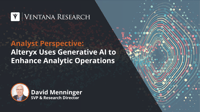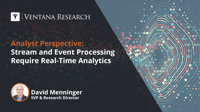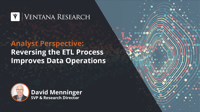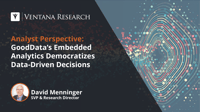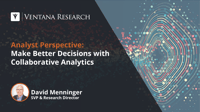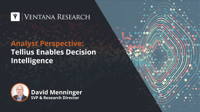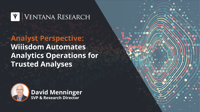We’ve been saying for years that natural language processing (NLP) and natural language analytics would greatly expand access to analytics. However, prior to the explosion of generative AI (GenAI), software providers had struggled to bring robust natural language capabilities to market. It required considerable manual effort. Many analytics providers had introduced natural language capabilities, but they didn’t really resonate with enterprise requirements. They required significant effort to...
Read More
Topics:
Business Intelligence,
Artificial intelligence,
natural language processing,
AI & Machine Learning,
Analytics & Data,
GenAI
Alteryx was founded in 1997 and initially focused on analyzing demographic and geographically organized data. In 2006, the company released its eponymous product that established its direction for what the product is today. In 2017, it went public in an IPO on the NYSE. At the time of the IPO, Alteryx was focusing much of its marketing efforts on the data preparation market, particularly to support Tableau. Throughout this time though, Alteryx offered much more than data preparation. As a...
Read More
Topics:
Analytics,
Business Intelligence,
data operations,
AI & Machine Learning,
Analytics & Data,
Analytic Operations
In my past perspectives, I’ve written about the evolution from data at rest to data in motion and the fact that you can’t rely on dashboards for real-time analytics. Organizations are becoming more and more event-driven and operating based on streaming data. As well, analytics are becoming more and more intertwined with operations. More than one-fifth of organizations (22%) describe their analytics workloads as real time in our Data and Analytics Benchmark Research and nearly half (47%) of...
Read More
Topics:
Analytics,
Business Intelligence,
Data,
Digital Technology,
Streaming Analytics,
Analytics & Data,
Streaming Data & Events
Organizations are continuously combining data from diverse and siloed sources for analytical, artificial intelligence and machine learning projects. As the volume of data grows, it becomes challenging for organizations to manage and keep current to extract valuable insights in a timely manner.
Read More
Topics:
Analytics,
Business Intelligence,
AI & Machine Learning,
Data Analytics
At one point, analytics and business intelligence were considered non-mission critical activities. One of the primary concerns in designing analytics systems was to ensure they didn’t interfere with or draw computing resources away from operational systems. But today, analytical systems are integral to many aspects of operations. More than 9 in 10 participants in our Analytics and Data Benchmark Research reported analytics had improved activities and processes. However, most analytics and BI...
Read More
Topics:
Analytics,
Business Intelligence,
Data Management,
Data,
Digital Technology,
data operations,
Analytics & Data
The current market landscape of data and analytics is undergoing rapid evolution, presenting organizations with a wide array of challenges and opportunities. As data sources and warehouses steadily migrate to the cloud, a significant number of organizations still depend on conventional tools. This reliance on legacy systems hinders the seamless accessibility and adoption of analytics and business intelligence within business processes. Organizations are increasingly turning to embedded...
Read More
Topics:
embedded analytics,
Analytics,
Business Intelligence,
Streaming Analytics,
AI & Machine Learning
MicroStrategy is a long-standing business intelligence and analytics vendor that operates worldwide. Founded in 1989, this publicly traded company with hundreds of millions of dollars in revenue recently held its first in-person conference since prior to the pandemic. Similar to previous in-person events, the event was well attended by about 2,000 attendees and exhibitors. The theme, “MicroStrategy ONE,” is a way to explain the breadth of capabilities the company offers. The breadth of the...
Read More
Topics:
embedded analytics,
Analytics,
Business Intelligence,
Digital Technology,
natural language processing,
Analytics & Data
In my perspective on decision intelligence, I lamented the fact that business intelligence technologies have left the rest of the exercise to the reader for too long. Making a decision is a process that involves many steps and many people. Decision-making is so complicated and divorced from day-to-day business processes that organizations have had to create entirely separate teams to focus on the analytics and data to support it. One aspect of the decision-making process that can be enhanced by...
Read More
Topics:
Analytics,
Business Intelligence,
Digital Technology,
Analytics & Data,
Collaborative & Conversational Computing
Organizations are continuously searching for new business opportunities hidden in their data. They are using various technologies including artificial intelligence and machine learning (AI/ML) to uncover granular insights that can support decision-making. Existing tools and dashboards are effective for observing standard metrics; however, they do not address follow-up questions, such as why things are happening or how those events impact performance. Organizations also struggle to derive...
Read More
Topics:
Analytics,
Business Intelligence,
natural language processing,
AI & Machine Learning,
Decision Intelligence
Data analytics provide valuable insights and enable organizations to make better decisions, improve performance and gain a competitive advantage in the marketplace. Analytics can change frequently depending on the data being analyzed and the methods used to gather and process it. Factors such as new data, changes in the underlying systems or updates to algorithms can all contribute to differences in an analysis. AnalyticOps helps ensure data is accurate, up-to-date and consistent across...
Read More
Topics:
embedded analytics,
Analytics,
Business Intelligence
